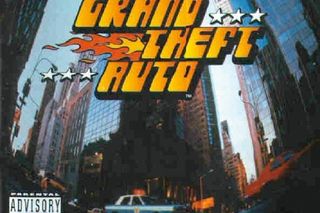A diverse range of tunes was also needed to make the radio convincing. "It wasn't good enough for the music to sound good enough for game music; people had to believe they were listening to real bands they just hadn't heard of," as Anderson puts it.
This proved very useful for DMA lyricist and PR head Brian Baglow - and was taken somewhat literally - when publicising the game. "I let it be known that the bands and tracks were all real and licensed especially for the game," perhaps one of the more understandable exaggerations. Sadly not all the audio work could be used. The tank, for example, lost an interesting-sounding, if perhaps credibility-straining, version of the Star Spangled Banner.
With audio, graphics, the living city and the game's mission structure finally coming together, Grand Theft Auto was released to immediate success, justifying the enormous effort and compensating to some degree for the immense amount of lost work. Jones' determination, and BMG's indulgence, received their just rewards.

Above: Sold as the videogame equivalent of an NWA album, GTA recognised the universal marketing value of controversy
Unfortunately, having helped to create such a success, BMG pulled out of the games market shortly afterwards, much to Jones' regret: "It helped create one of the biggest games ever but didn't stay around long enough to enjoy it. BMG really would have been great for the industry."
GTA is often seen as inventing the sandbox genre, but in truth it built upon a strong heritage of arcade and freeform games. Even the game's trademark carjacking had been seen in Hunter and Mercenary before that. Its unique achievement was to take the best from what had gone before and fuse it together with ambition, skill and incredible attention to detail. That process was a complicated one, but the idea at the heart of GTA wasn't.
Sign up to the GamesRadar+ Newsletter
Weekly digests, tales from the communities you love, and more
The word that comes up again and again when talking to its creators is 'fun'. If an opportunity arose to make the game more fun, no matter who it came from, and even if it meant throwing away a huge amount of work, it was seized with both hands. The series that resulted has been copied countless times, but few imitators have stopped to think that the secret to its success may lie in the process, not the product.
Above: Sold as the videogame equivalent of an NWA album, GTA recognised the universal marketing value of controversy
Unfortunately, having helped to create such a success, BMG pulled out of the games market shortly afterwards, much to Jones' regret: "It helped create one of the biggest games ever but didn't stay around long enough to enjoy it. BMG really would have been great for the industry."
GTA is often seen as inventing the sandbox genre, but in truth it built upon a strong heritage of arcade and freeform games. Even the game's trademark carjacking had been seen in Hunter and Mercenary before that. Its unique achievement was to take the best from what had gone before and fuse it together with ambition, skill and incredible attention to detail. That process was a complicated one, but the idea at the heart of GTA wasn't.
The word that comes up again and again when talking to its creators is 'fun'. If an opportunity arose to make the game more fun, no matter who it came from, and even if it meant throwing away a huge amount of work, it was seized with both hands. The series that resulted has been copied countless times, but few imitators have stopped to think that the secret to its success may lie in the process, not the product.
Most Popular
